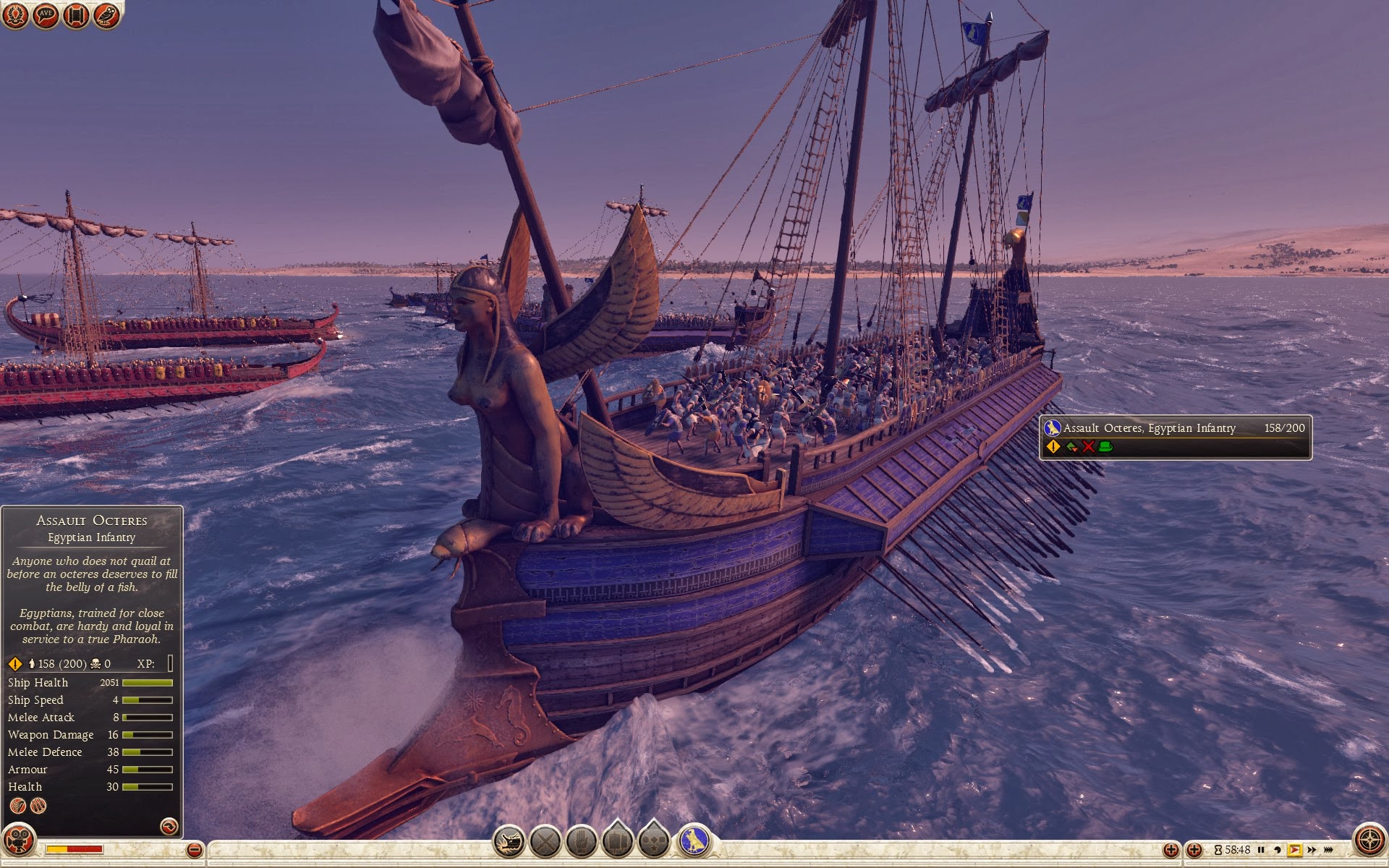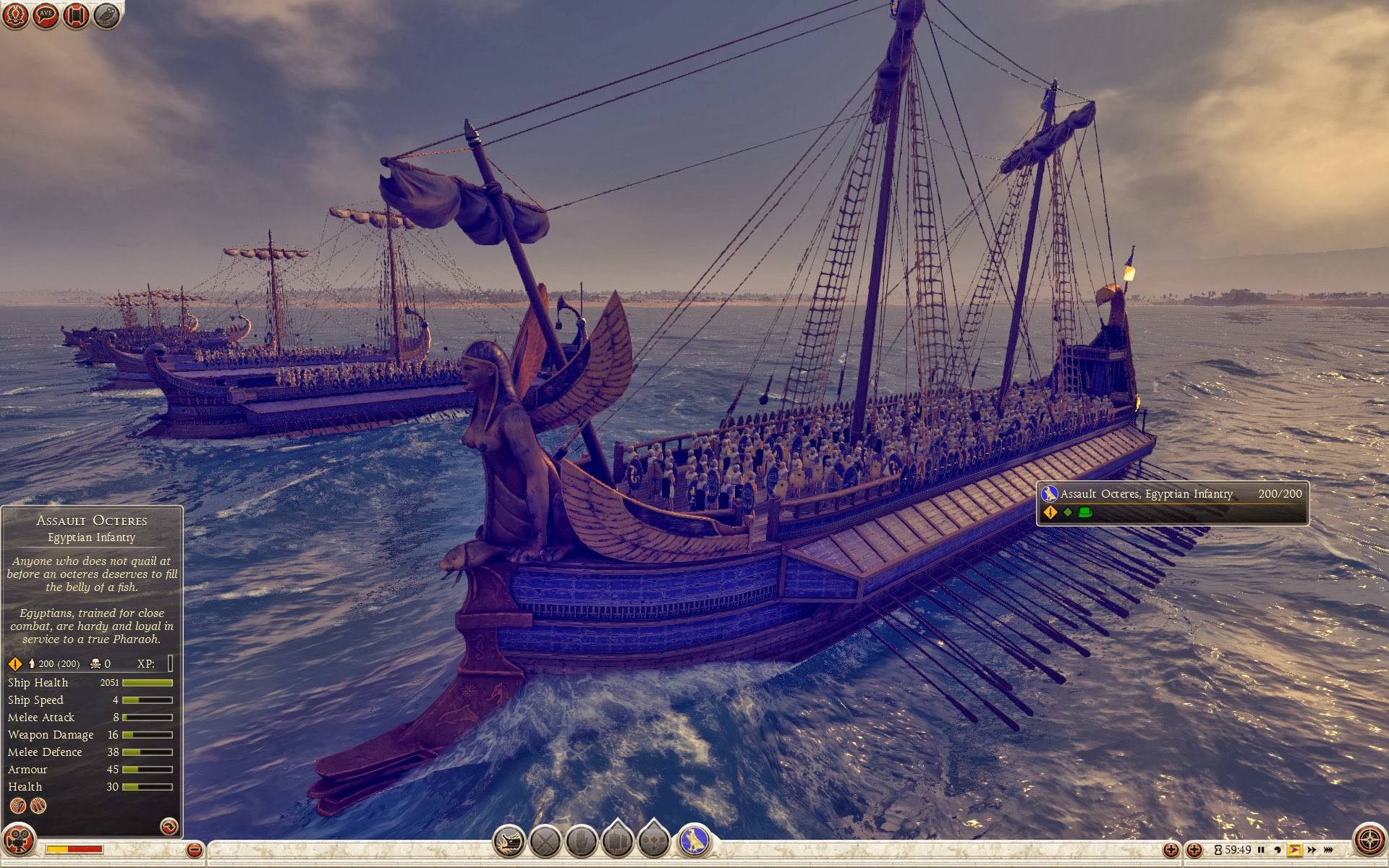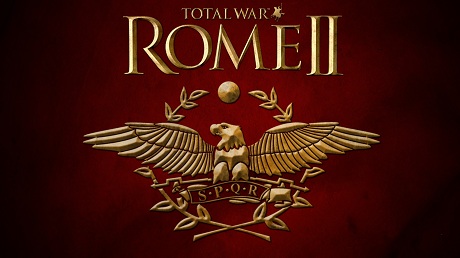Assault Octeres - Egyptian Infantry
Anyone who does not quail before an octeres deserves to fill the belly of a fish.Egyptians, trained for close-combat, are hardy and loyal in the service of a true Pharaoh.
An arms race in warship size developed between the various nations around the Mediterranean. Size, in terms of the number of rowers, ships length and bulk and above all majesty of the vessel became as much a tool of statecraft as of warfare. A people who could afford such ships were almost certainly rich enough to withstand the strains of any war. A 'four' or quadreme was still a handy warship, able to manoeuvre in battle. The same could not be said of some of the large polyremes, a word meaning many oars. Practical archaeology shows that too many banks of oars simply don't work, so polyreme probably referred to the number of rowers: an octeres is likely to have had some eight rowers per bank of three oars, arranged in three, three, and two to an oar going up from the waterline. King Demetius of Macedon led his fleet at the battle of Salamis in 306BC from the deck of a hepteres or 'seven', but his ambitions didn't stop there. Neither did those of other kingdoms, and later lumbering warships including 'elevens', 'thirteens' and larger. As bigger ships to carry more rowers such vessels could also carry big marine contingents, arrow towers and an array of useful artillery.
(Egyptian Infantry)
Native troops supported the Greek phalanxes of Ptolemaic Egypt. Brave and proud warriors, Egyptians fulfilled several roles, but were most commonly used as peltasts, skirmishers on the flanks of the phalanxes, or as non-phalanx infantry in difficult terrain. Although the Ptolemies adopted all the trappings of the Pharaohs and their religious infrastructure, there was still much unrest among the native population long after the succession. This was due mainly to the way the Greek overlords used the traditions of the Pharaohs to fill their coffers at the expensive of ordinary people. The core of Ptolemaic armies was always Greek until the Battle of Raphia in 217BC, when they faced such a large Seleucid force and Ptolemy IV was forced to muster some 30,000 native Egyptians for the first time. Need overcame the suspicion of the disenchanted natives; the performance of the Egyptians in battle eventually led to a greater proportion of native troops in the Egyptian army and, in time, more diverse roles for those men as they gained the trust of their Greek commanders.
Unit Name Assault Octeres - Egyptian Infantry |
Main Unit Key Egy_Infantry_Eight |
Land Unit Key Egy_Infantry |
Naval Unit Key egyptian_eight |
Soldiers 200 |
Category Heavy Ship |
Class Melee Ship |
Custom Battle Cost 1450 |
Recruitment Cost 1450 |
Upkeep Cost 290 |
Missile Damage 32 |
├ Missile Weapon rome_javelin_precursor |
├ Projectile javelin_prec |
├ Missile Damage 20 |
├ Missile Ap Damage 12 |
└ Base Reload Time 15 |
Accuracy 5 |
Range 40 |
Reload 0 |
Shots Per Minute 4 |
Ammunition 2 |
Ship Health 2051 |
└ Ship egyptian_eight |
Ship Speed 4 |
Melee Attack 14 |
Weapon Damage 24 |
├ Melee Weapon rome_shortsword |
├ Melee Damage Base 20 |
├ Melee Damage Ap 4 |
├ Armour Piercing No |
├ Bonus vs. Large 0 |
├ Bonus vs Elephants 0 |
└ Bonus vs Infantry 0 |
Charge Bonus 8 |
Melee Defence 39 |
├ Base Defence 14 |
├ Shield thureos |
└ Shield Defence 25 |
Armour 55 |
├ Armour padded |
├ Armour Defence 20 |
└ Shield Armour 35 |
Health 45 |
├ Man Entity rome_infantry_medium |
├ Man Health 40 |
└ Bonus Hit Points 5 |
Base Morale 30 |
Abilities
Assault Octeres- Row Hard 30
Increases speed for 30 strokes.
Ship speed
Attributes
- Hide (forest)
This unit can hide in forests until enemy units get too close. - Resistant to Heat
This unit tires less quickly in the desert.
Strengths & Weaknesses
Assault Octeres- Unbeatable hull strength
- Very heavy crew
- Very slow speed
- Strong ramming
- Indomitable boarding
- Average attack
- Weak defence
- Average damage but low armour penetration
- Poor morale
| Faction Availability | |
|---|---|
| Grand Campaign | |
| Imperator Augustus | |


 Français
Français Italiano
Italiano Deutsch
Deutsch Español
Español Русский
Русский Čeština
Čeština Polski
Polski Türkçe
Türkçe 简体中文
简体中文 正體中文
正體中文 日本語
日本語






